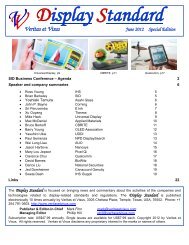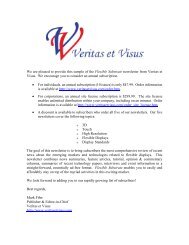Create successful ePaper yourself
Turn your PDF publications into a flip-book with our unique Google optimized e-Paper software.
<strong>Veritas</strong> <strong>et</strong> <strong>Visus</strong> <strong>Display</strong> <strong>Standard</strong> February 2009<br />
<strong>Display</strong>Mate introduces new motion blur measurement system<br />
<strong>Display</strong>Mate introduced Multimedia with Motion Bitmaps Edition that moves test patterns and test photos to<br />
measure, and evaluates motion blur in HDTVs and computer monitors. With it, one can visually measure the true<br />
response time in milliseconds for different gray-to-gray transitions on-screen with just the eyes alone. You simply<br />
interactively vary the speed of a calibrated test pattern until the blur matches a specific width on the test pattern and<br />
<strong>Display</strong>Mate tells you immediately on-screen what the response time is. You’ll see that the blur and response time<br />
vary significantly for different gray-to-gray transitions and that the response times for most transitions are<br />
considerably longer than the published specifications. Besides test patterns there are also 40 photographs that are<br />
moved on-screen so you can visually evaluate how motion blur affects real images. In addition to motion blur,<br />
<strong>Display</strong>Mate will also show all sorts of bizarre motion artifacts that affect all display technologies except CRTs.<br />
These arise from the display driver and signal processing electronics, and frequently from algorithms designed to<br />
reduce motion blur, which introduce their own artifacts. Since many displays have one or more user options for<br />
reducing motion blur you can visually compare them. <strong>Display</strong>Mate Multimedia with Motion Bitmaps Edition runs<br />
on any 32-bit version of Windows XP or Vista. It runs automatically and instantly from the supplied USB drive - no<br />
installation necessary. It works with any type of analog or digital connection supported by a PC and HDTV or<br />
computer monitor (but HDMI and DVI are best). http://www.displaymate.com/hdtv_cal.html<br />
Green electronics round-up<br />
compiled by Keith Baker with additional material by Phillip Hill<br />
Keith J. Baker is project researcher at the Scottish Institute of Sustainable Technology<br />
(SISTech, www.sistech.co.uk) a not-for-profit sustainable development consultancy based<br />
at Heriot-Watt University, Edinburgh, Scotland. He is a 2003 graduate of the<br />
<strong>Display</strong>Masters program and has a PhD in Domestic Energy Consumption from the<br />
Institute of Energy and Sustainable Development, De Montfort University, Leicester,<br />
England, with a background in environmental science and science policy. He has a keen<br />
interest in the energy efficiency and environmental impact of new technology, particularly<br />
relating to displays. http://www.linkedin.com/in/keithjbaker<br />
Happy New Year to all our readers and g<strong>et</strong> ready, 2009 looks s<strong>et</strong> to be a big one. To kick<br />
things off we look forward to what the EU has in store this year – and there’s a lot of it<br />
coming our way. We finally have some good news from the One Laptop Per Child<br />
project, which this column has been following and supporting since it began; and we couldn’t l<strong>et</strong> some minor news<br />
about a certain election go by without a comment. Congrats to our US readers!<br />
The EU Directives – What’s in store for 2009?<br />
For the displays and electronics industries 2008 was a relatively qui<strong>et</strong> year by EU policy-making standards.<br />
REACH continued to make slow but rumbling progress, the WEEE and RoHS reviews got underway, and EuP took<br />
its first tentative but promising steps with the release of the first batch of eco-design guidelines and the<br />
announcement of the stepped phasing out of conventional light bulbs. So now that you’ve had a chance to take a<br />
time out, g<strong>et</strong> ready for the next round in 2009.<br />
Perhaps most importantly, the results of the RoHS review will soon be upon us. As covered here previously it is<br />
safe to assume that many of the current exemptions will go, although a few new ones may be added, new product<br />
categories will join those already covered, and the list of restricted substances will grow. Early indications are that<br />
the latter will cause the biggest problems, with Denmark leading the call for more and tougher restrictions along<br />
with Norway, which is a non-EU state but is allowed input to the process and is s<strong>et</strong> to announce its own version<br />
around the same time. The revision will also bring the restriction and monitoring elements of RoHS and REACH in<br />
line with each other, meaning less paperwork for manufacturers than previously feared. One substance that will<br />
77






